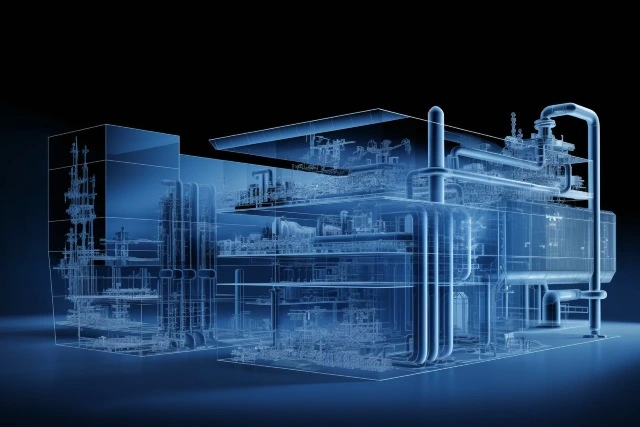When it comes to maintaining a comfortable and healthy indoor environment, traditional ventilation systems often fall short. Oftentimes, they operate inefficiently which leads to excessive energy consumption and skyrocketing utility bills. Energy recovery ventilation (ERV) provides an elegant solution to this age-old problem. By harnessing the power of heat and moisture exchange, ERV systems bring a breath of fresh air into commercial buildings, literally and figuratively.
What is meant by energy recovery ventilation?
Energy recovery ventilation brings in fresh air while keeping energy costs in check by using a process of heat and moisture exchange. Unlike traditional systems, ERV captures the energy from outgoing air in HVAC systems to minimize waste and reduce energy costs.
How does the process work?
At the heart of energy recovery ventilation is the heat exchanger which acts as a gatekeeper to transfer heat and moisture between outgoing and incoming air. It uses outgoing air to precondition incoming air before fully heating or cooling the air to comfortable indoor temperatures. On top of heat transfer, the heat exchanger also maintains humidity levels using outgoing air to increase or decrease the humidity of incoming air.
What is the difference between ERV and HRV ventilation?
While both energy recovery ventilation and heat recovery ventilation (HRV) share the goal of improving indoor air quality, they differ in their approaches. As mentioned, ERV exchanges both heat and moisture. HRV only exchanges heat. This makes HRV a less expensive system, but ERV offers higher energy savings in climates with significant variations in temperature and humidity.
Which one is the more efficient HVAC system for commercial buildings?
When it comes to real estate energy efficiency in HVAC systems, ERV always offers more efficiency than HRV. It offers preconditioning for both temperature and humidity levels, reducing the strain on heating and cooling systems while providing a more comfortable indoor environment. However, in climates with consistent humidity levels, HRV systems can nearly match the efficiency of ERV systems while costing less.
The most important benefits of ERV systems in Proptech
Energy recovery ventilation systems bring significant benefits to commercial real estate (CRE) including:
- Improved indoor air quality: By removing allergens and pollutants, ERV systems ensure clean, fresh air for occupants.
- Energy efficiency: To save energy and lower utility bills, ERV systems recover energy from exhaust air.
- Cost savings: Reducing energy consumption leads to cost savings based on the efficiency of your current heating and cooling systems. You can use building management systems to estimate the cost savings of an ERV system in your building.
- Sustainability: ERV systems align with green building practices by reducing greenhouse gas emissions.
Are there any disadvantages of ventilatory support?
Although the benefits outweigh the disadvantages in most circumstances, ERV systems come with a few drawbacks including:
- Initial cost: The installation of ventilatory support systems requires a higher upfront investment compared to traditional HVAC setups.
- Maintenance and upkeep: Regular maintenance is required to ensure optimal performance, including cleaning or replacing filters and components.
- Specialized expertise: Installation and some maintenance items require specialized experts in ERV systems.
Finding the ideal energy recovery ventilation solution for your CRE building
When choosing an ERV solution for your CRE building, consider the following:
- Assess your building: Understand your building’s size, occupancy, and existing HVAC setup to determine the ERV system’s capacity and specifications.
- Evaluate energy recovery efficiency: Look for systems with effective energy transfer between air streams, using advanced heat exchangers and efficient fan motors.
- Prioritize air quality: Choose systems with quality filters to trap allergens and pollutants, and consider options for humidity control.
- Check integration capabilities: Ensure the system seamlessly integrates with your current HVAC infrastructure for smooth operation.
- Seek expert advice: Consult experienced professionals who can provide insights, conduct energy audits, and recommend customized ERV solutions.
Why you definitely need it
Embracing the power of energy recovery ventilation is a strategic move that brings unmatched advantages. From revitalizing indoor air quality and revolutionizing energy efficiency to slashing operational costs and championing sustainability, ERV systems unlock the full potential of your commercial building.
You can expand your building’s capabilities and fully leverage your energy recovery ventilation by integrating it with your other Proptech solutions. ProptechOS acts as your building operating system to create a unified ecosystem for all of your building technology. All of ProptechOS partners easily integrate into the ProptechOS ecosystem to make this process even easier. Try ProptechOS for free to see how integrating your Proptech can improve your building’s operations.

Dr. Erik Wallin
Chief Ecosystem Officer, and founder of ProptechOS and RealEstateCore is recognized as a leader in Building Operating Systems (BOS) and making the buildings of the world smarter. He holds an MSc and a Ph.D. in Media and Computer Science from KTH Royal Institute of Technology.
Read his full bio and information here.

